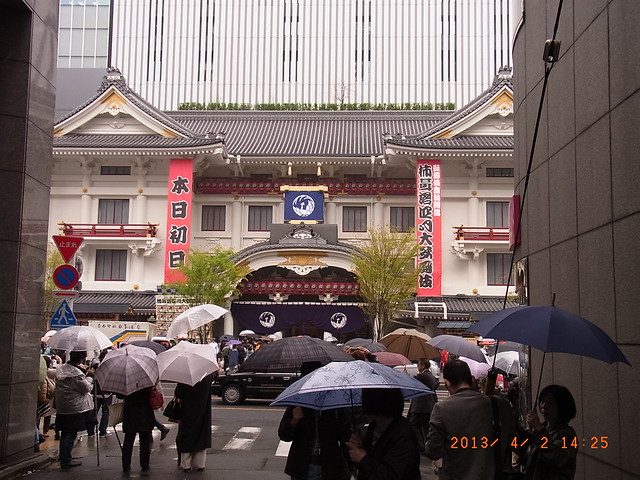 |
| R0024620 by urasimaru /flickr |
The fifth-generation Kabuki-za Theater reopened on April 2. It rained on the opening day. The Doors opened with the beating of a drum.
 |
| Kabuki-za by knhiraoka /flickr(the former kabuki-za) |
Its appearance is left in its original state. Its first generation building was built in 1889.
information about kabukiza:
http://www.kabuki-bito.jp/eng/contents/theatre/kabukiza.html
http://www.kabuki-za.co.jp/
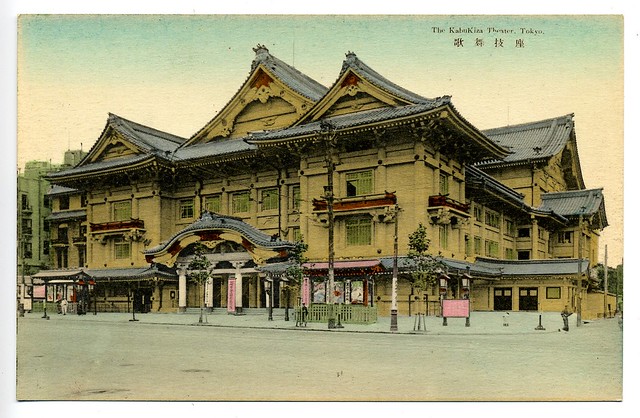 |
| Kabukiza Theater, Ginza, Tokyo by born1945 /flickr |
Kabuki is said to have originated from "IZUMO no Okuni," a female traveling dancer. She delivered a performance at Kitano Tenman-gu Shrine in 1603. As she became popular, many imitators including prostitutes and teenage boys appeared. Since they were accompanied by male/female prostitution and other undesirable activities, then government banned women performers in 1629, and teenage male performers in 1652.
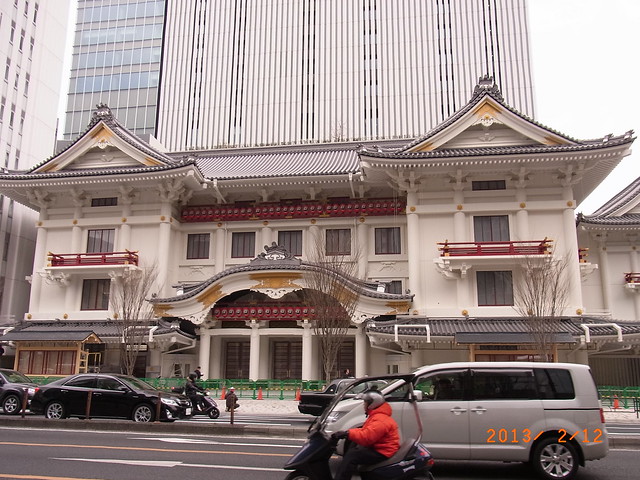 |
| R0023863 by urasimaru /flickr |
Some theaters for kabuki performances used to be located at Ginza around 1660. Successful Edo Period businessmen of the fish market were patrons of kabuki players such as the Ichikawa family. Kabuki-za is close to Tsukiji and Ginza. The audience can enjoy the fish market at Tsukiji, and shoppings or dinner at Ginza.
April Kabuki Program for Grand Opening of Kabukiza Theatre is being held from April 2 to 28.
The theater was rebuild because the building became too old and have poor earthquake resistance strength, and its facilities are not yet barrier free. A writer was seeing a kabuki play at an another theater on March 11 in 2011. She said that the large earthquake might have caused casualties if a kabuki play had been performed at the former kabukiza theater.
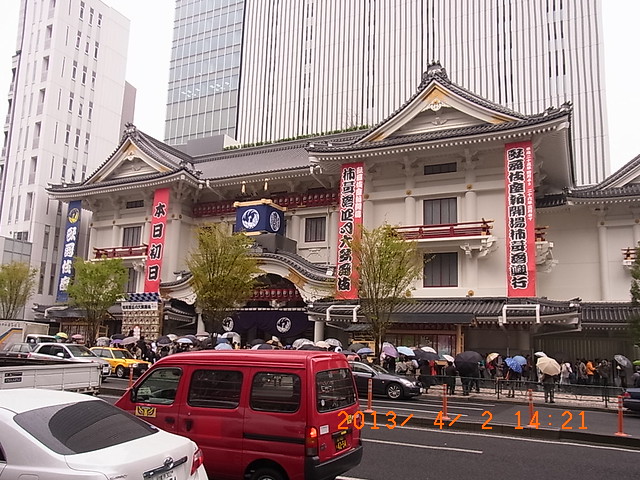 |
| R0024616 by urasimaru /flickr |
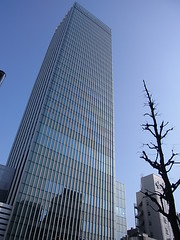 |
| R0024077 by urasimaru /flickr |
The Kabukiza Tower, a 29-story office building, stands behind the theater.
Bunraku would not survive without government subsidies. In contrast, the subsidies are not used for kabuki performances. The subsidies are used to train kabuki successors.
However, those involved have a sense of crisis about the future of kabuki. Regulars are aging. They expect to secure a stable source for business income by getting office rents.
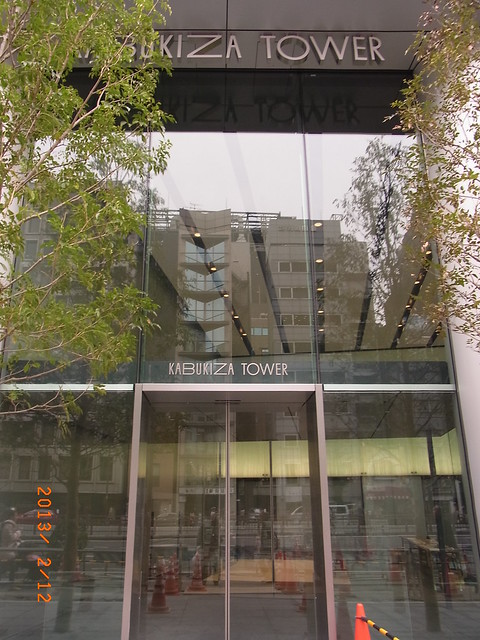 |
| R0023891 by urasimaru /flickr |
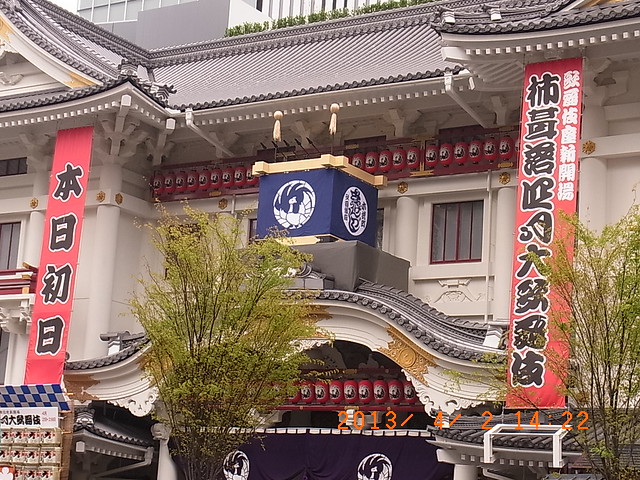 |
| R0024618 by urasimaru /flickr (Kabukiza Theater with banners and yagura) |
Yagura is a wooden cubic frame covered with blue cloth on which is dyed a large pattern of the theater's crest "hoo (鳳凰, mythological sacred bird in Chinese lore, Chinese phoenix) ." In the Edo Period, only playhouses authorized by the feudal government could put yagura up. Yagura will remain there until next March.
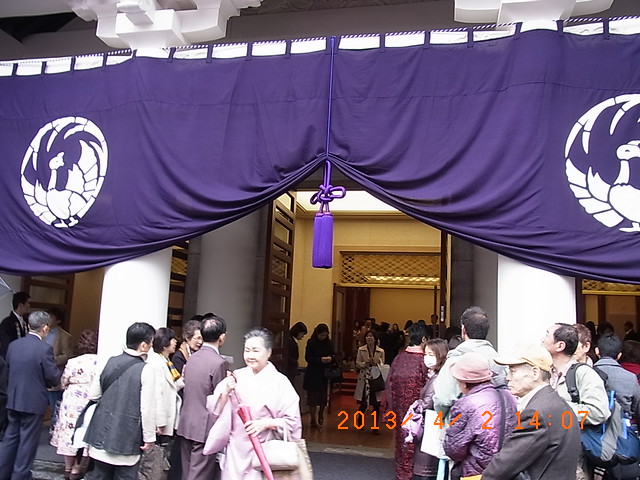 |
| R0024602 by urasimaru /flickr (main entrance) |
The audience can have a meal at the restaurants in the theater, but reservations are recommended. The audience can eat box lunch in their seats. Japanese boxed lunch are available at the lunch box shop on the second basement of the tower and at the drink stands on the 1st, 2nd, third floor of the theater.
In the second basement of the tower, there are a soba shop, a grocer's, a lunch box shop, a coffee shop, a convenience store, a souvenir shop, and kabukiza box office. A large space on the floor can be used as a temporary shelter for people who have difficulty returning home when a disaster strikes.
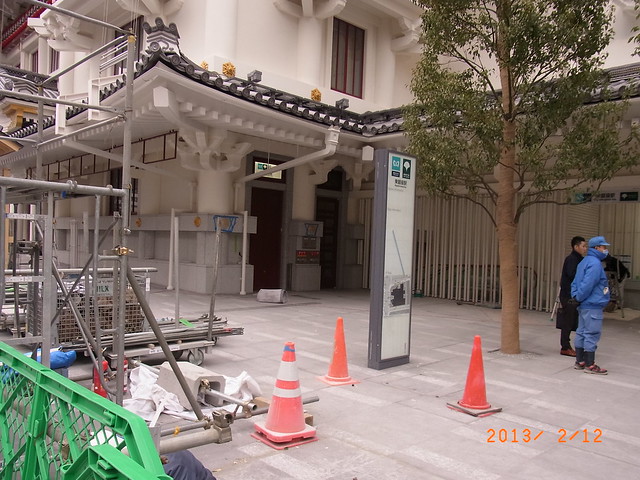 |
| R0023869 by urasimaru /flickr |
subway entrance on the first floor
After taking the escalator or elevator from the second basement of the tower to the first floor of the theater, the audience can enter the theater through the main entrance without wetting oneself.
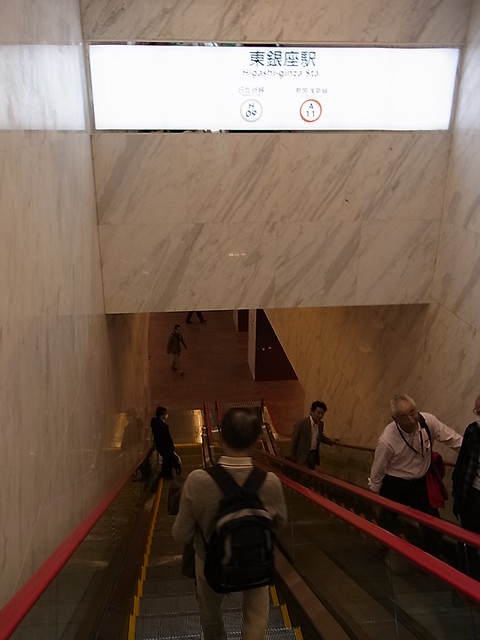 |
| R0024085 by urasimaru /flickr |
subway entrance
Higashiginza Station on the Tokyo Metro Hibiya Line and Toei Subway Asakusa Line has direct access to the second basement of the tower.
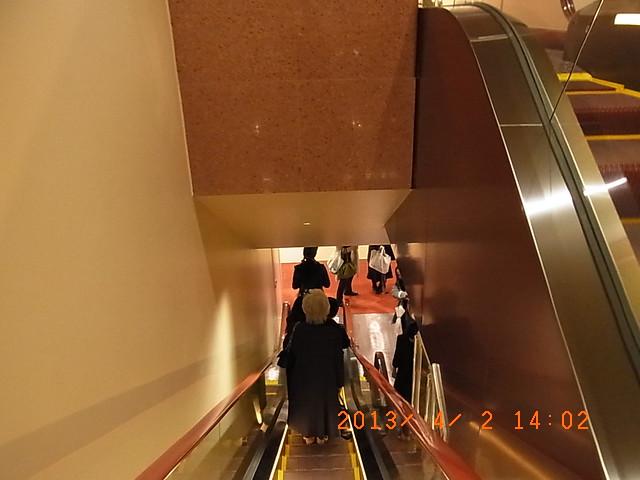 |
| R0024595 by urasimaru /flickr |
a single-width escalator
The first basement of the theater has coin lockers.
On the first floor, there are audience seats, a souvenir shop, a coffee shop. It seems that the coffee shop is available for even non-audience ones.
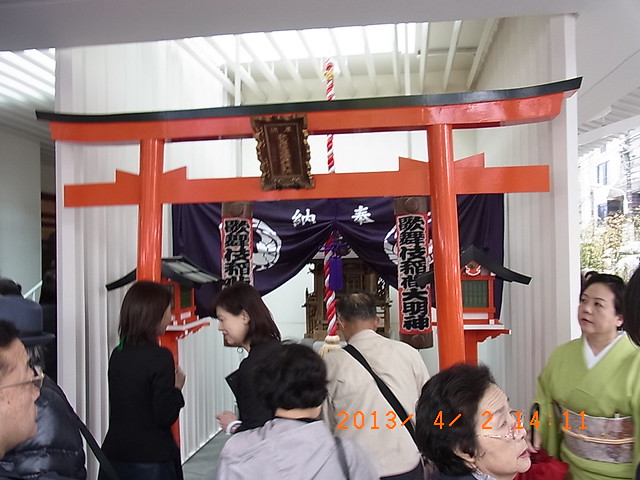 |
| R0024610 by urasimaru /flickr Kabuki Inari Jinja |
There is a small shrine called Kabuki Inari Jinja(歌舞伎稲荷神社) near the escalator on the first floor.
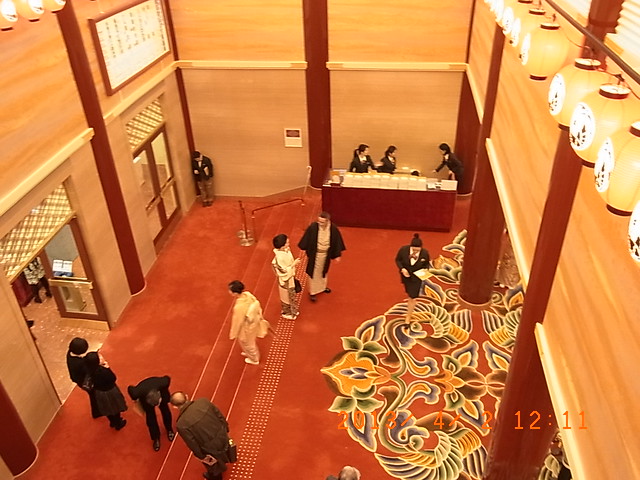 |
| R0024582 by urasimaru /flickr |
lobby covered with a hoo(Chinese phoenix) pattern carpet on the first floor
 |
| R0024576 by urasimaru /flickr |
Kabuki connoisseurs on the third floor call out with precise timing such as "Naritaya!(the actor's hereditary stage name)","Matte-mashita!(We've been waiting for you!)." They do to liven up the play. If someone calls out with bad timing, one would spoil the play.
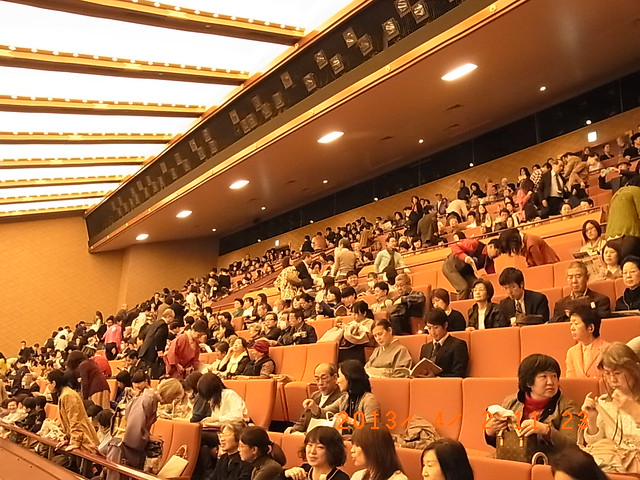 |
| R0024578 by urasimaru /flickr |
The seats on the 1st and 2nd floor became more spacious than before. Some new stage settings have been installed.
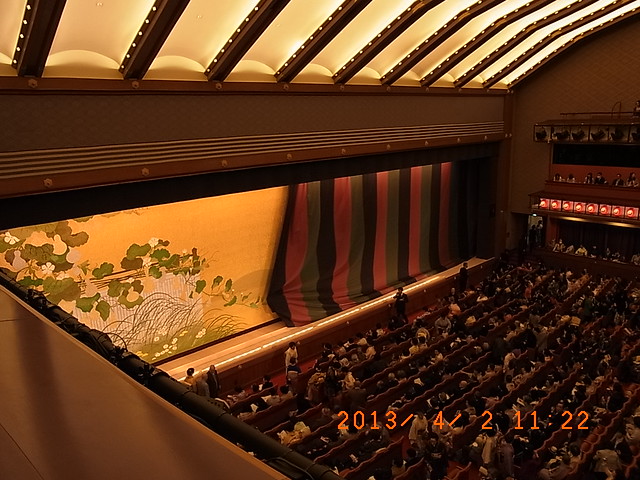 |
| R0024577 by urasimaru /flickr |
 |
| R0026340 by urasimaru /flickr |
The audience can rent portable video monitors on which the lines and the explanation of the scenes are displayed. Holders for the monitors are installed on the back of the front seat backrests.
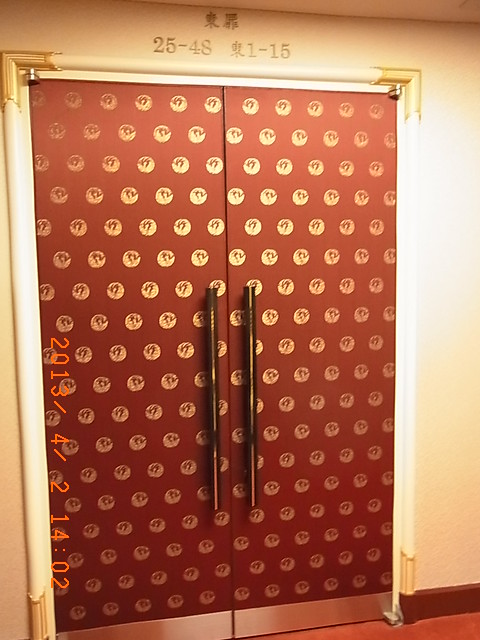 |
| R0024594 by urasimaru /flickr |
 |
| 歌舞伎座 Kabukiza / na0905 /flickr (hanamichi at the former kabuki-za) |
Hanamichi is like a runway in fashion show. Main actors often enter and exit via the hanamichi acting. The audience seated close to the hanamichi can almost reach out and touch the actors when they appear along the hanamichi. Some people say that several seats have trouble seeing the play or hanamichi.
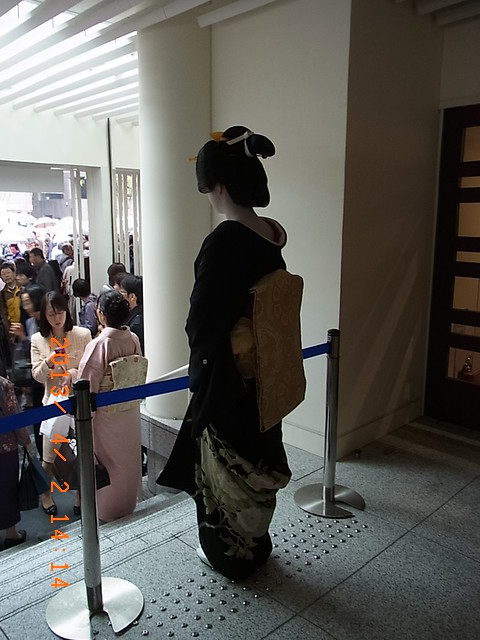 |
| R0024614 by urasimaru /flickr |
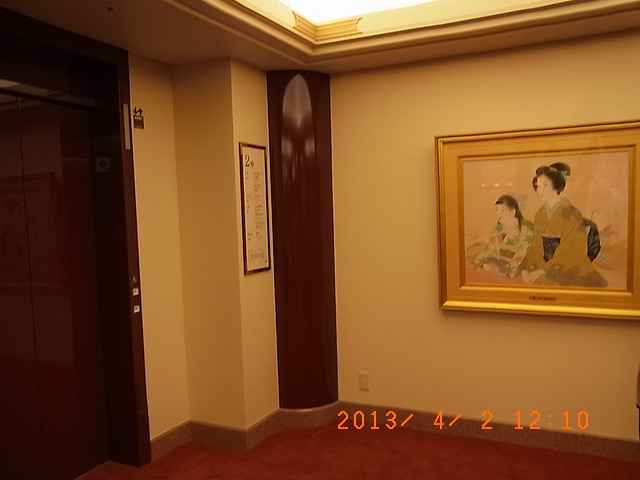 |
| R0024580 by urasimaru /flickr |
Sajiki(さじき, box-seat) by Kiyokata kaburaki(鏑木清方) around 1945
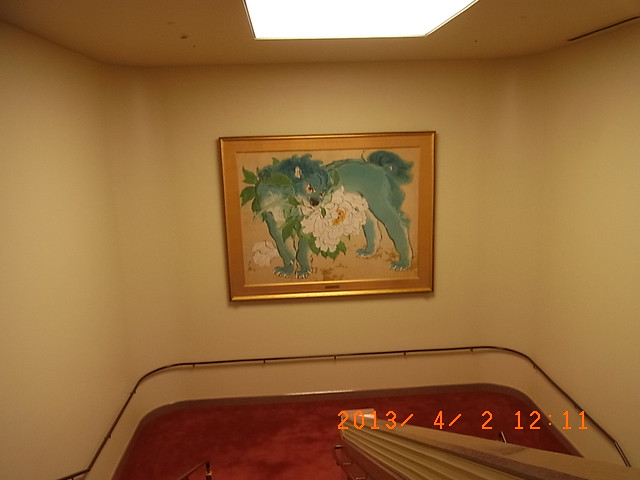 |
| R0024583 by urasimaru /flickr |
Aojishi(青獅子, blue lion) by Ryushi Kawabata(川端龍子) in 1950
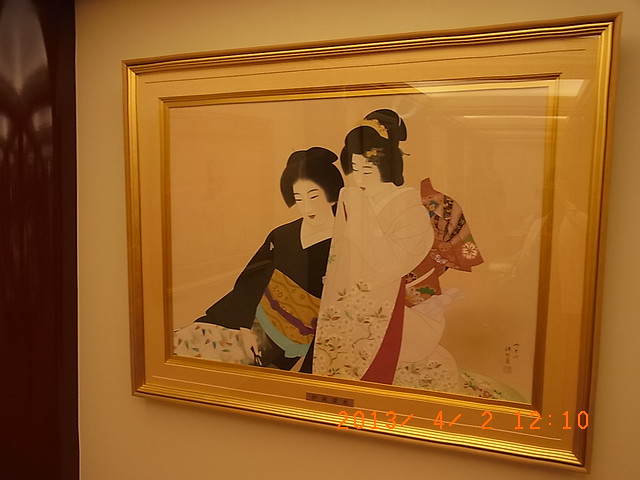 |
| R0024581 by urasimaru /flickr |
Shunsyo(春宵, spring evening) by Shinsui Ito(伊東深水) in 1950
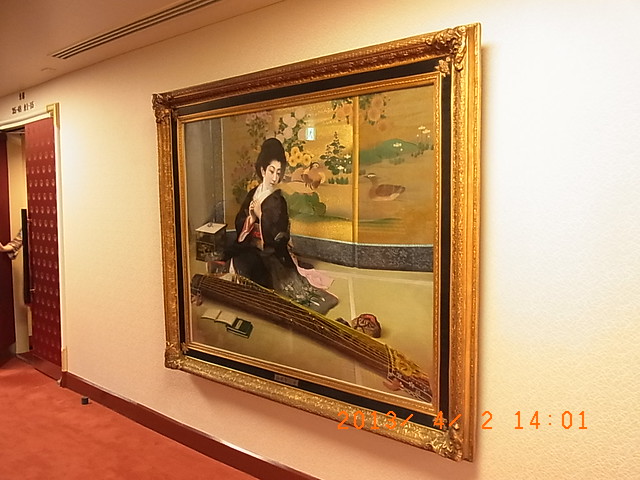 |
| R0024592 by urasimaru /flickr |
Sazanka no Tsubone(山茶花の局(美人弾琴図), Lady Sazanka) by Shiichi Kamei(亀井至一) in 1890
On the third floor, there are audience seats, restaurants, souvenir shops.
On the fifth floor, there is a rooftop garden. Visitors can also enjoy free admission to the garden. The garden has a stone lantern that Kawatake Mokuami(河竹黙阿弥, 1816-1893), a dramatist of Kabuki, owned. The garden has direct access to the fifth floor of the Kabukiza Tower.
On the tower's fifth floor, there are Kabukiza Theater Gallery, an exhibition space, a small event hall, a photo studio, a souvenir shop, a Japanese tea shop. The gallery shows stage costumes, set and props for kabuki plays. Events will be held by participators including young kabuki actors, the players of traditional Japanese music at the hall. At the photo studio, a photographer shoot pictures of visitors wearing costumes, makeup and hair for kabuki plays.
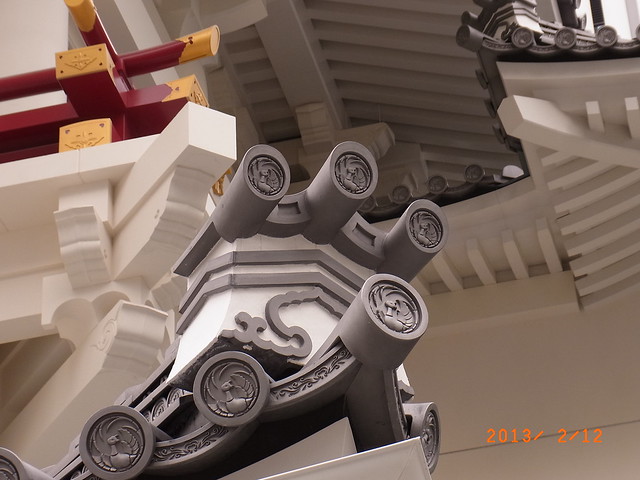 |
| R002387 by urasimaru /flickr |
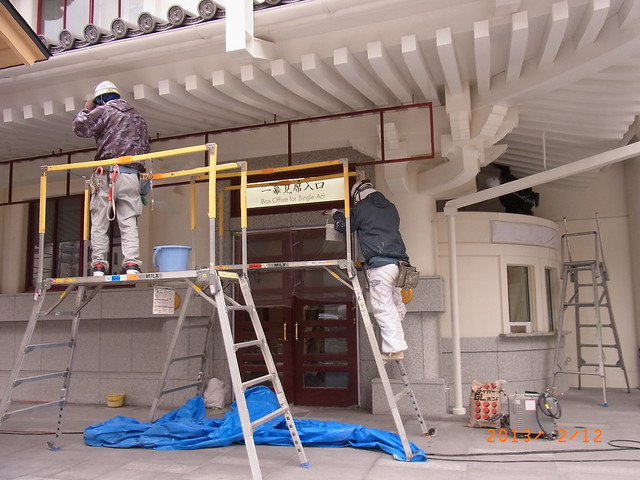 |
| R0023881 by urasimaru /flickr (box-office for single act) |
In the program of this month, the tickets cost from 22,000 yen to 4,000 yen.
Although seats for a single act(一幕見席, hitomakumiseki) cost 2,000 yen, the tickets for the seats are sold only on the day and cannot be reserved in advance. The seats include 96 seats and 60 standing seats.
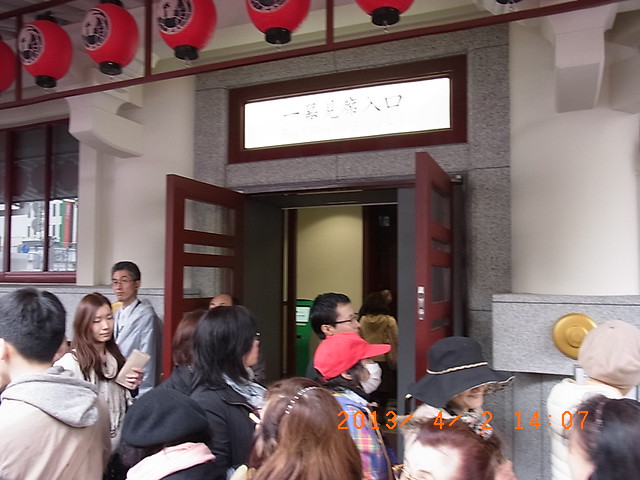 |
| R0024603 by urasimaru /flickr (box-office for single act on April 2) |
Many people line up to buy the tickets at the box-office for single act on the 1st floor of the theater. Earphone guides(Japanese and English version) are also available to the audience in the seats. The audience can use only a doorway leading into their seats on the fourth floor, and they are unavailable for restaurants and shops on the other floors of the theater.
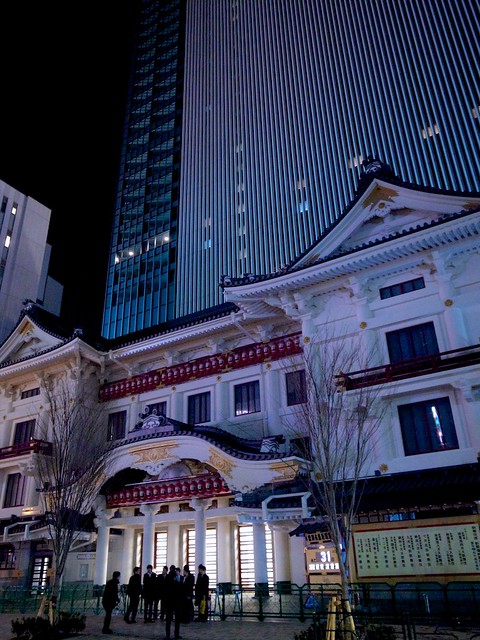 |
| 歌舞伎座 by mxmstryo /flickr |
A lot happened after the closing ceremony of the theater was held on April 30 in 2010.
In November, 2010, Ichikawa Ebizo XI(市川海老蔵) fractured his zygoma and a front tooth because of a violent incident during drinking.
In January, 2011, Nakamuara Tomijuro V(中村富十郎) died at the age of 81.
In October, 2011, Nakamuara Shikan VII(中村 芝翫) died at the age of 83.
In February, 2012, Nakamuara Jakuemon IV(中村 雀右衛門) died at the age of 91.
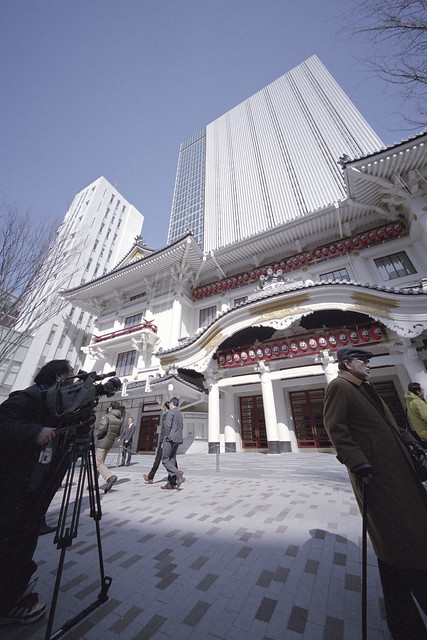 |
| 歌舞伎座 第5期 竣工式取材中 1 by fukapon /flickr |
On August 27 in 2012, Ichikawa Somegoro VII(市川染五郎) got whacked in the right side of the body and fractured his right wrist after he fell three meters into a trap cellar from the stage while dancing at the dance performance to celebrate the 70th anniversary of his father's birth. His father, Matusmoto Koshiro IX(松本幸四郎), said afterward that he prepared for the worst. The trap cellar under the stage or runway of a theater is called Naraku(奈落) in Japan. Naraku comes from Diyu (Sanskrit: "Naraka") which means "hell."
On December 5 in 2012, Nakamuara Kanzaburo XIII(十八代目 中村 勘三郎) died at the age of 57.
On February 3 in 2013, Ichikawa Danjuro XII(十二代目 市川 團十郞) died at the age of 66.
On February 26 in 2013, Onoe Kikunosuke V(尾上菊之助) married the fourth daughter of Nakamura Kichiemon II(中村吉右衛門) at the Kanda Myojin Shrine in Tokyo.
On February 26 in 2013, a ceremony to celebrate the completion of Kabukiza was held on the 29th floor of the Kabukiza Tower.
On February 27 in 2013, the funeral of Ichikawa Danjuro was held in light rain. In the case of funerals of some celebrities, a private funeral is observed first and then later a formal funeral is held. Many people came to convey their condolences. Unlike his son, he is said to have been a person of depth.
On March 22 in 2013, Ichikawa Ebizo's wife gave birth to a baby boy. Danjuro couldn't see the baby , but he knew that his grandson would come into the world. The baby is expected to follow his father and his grandfather in the family business.
On March 27 in 2013, about 120 people including 63 kabuki actors paraded down the street of Ginza. They were attired in traditional family crest-bearing kimono and hakama(pleated skirt). Despite the cold rainy weather, about 32,000 people filled the streets along the 400-meter route to catch a glimpse of the newlyweds.
People dressed as civil firemen in the Edo period led the procession while singing a kiyariuta(song for carrying heavy logs) and waving firefighters' banners. They are the members of a society for the cultural preservation of volunteer fire companies in the Edo Period.
On the afternoon of March 27 in 2013, the inauguration ceremony of the Kabukiza Theater was held at the theater. It was an invitation-only event. After a festive program was performed, 99 kabuki actors were in line on the stage. Some representatives address the audience, and all of them clapped their hands to celebrate the newborn Kabuki-za.
On March 28 in 2013, the ceremony of teuchi (Japanese custom of ceremonial rhythmic hand clapping, performed at a special event) was held at the theater. the ceremony is normally closed, but invited guests attended it this time. Usually only performers and theater officials attend this ceremony.
Wonderful pictures and commentary. I learned a lot. Next time I visit Tokyo I will definitely visit the Kabuki-za theater. Thank you.
ReplyDeleteThe number of visitors to the kabukiza is higher than originally anticipated. The theater has always been crowded since it reopened.
DeleteGreat readding this
ReplyDelete